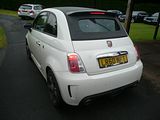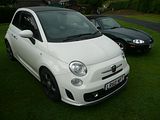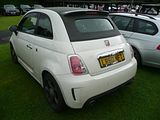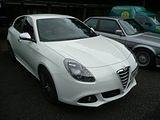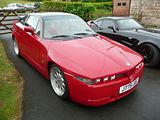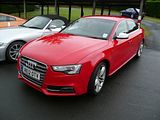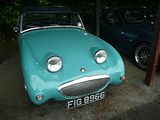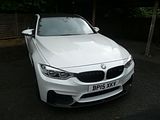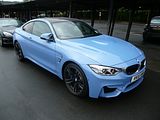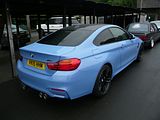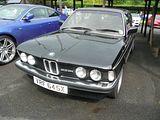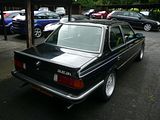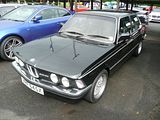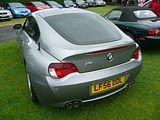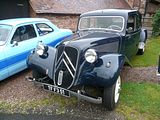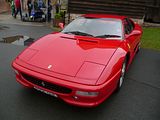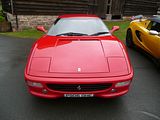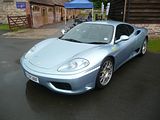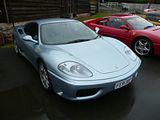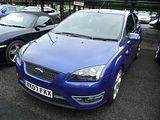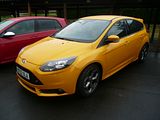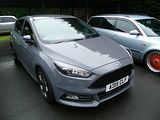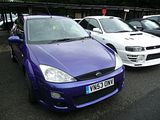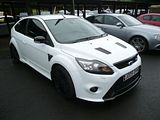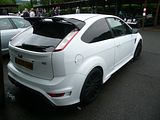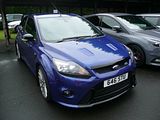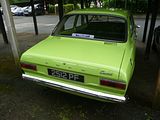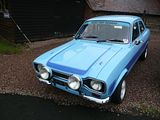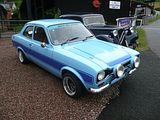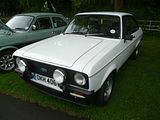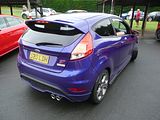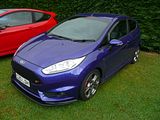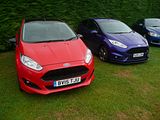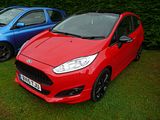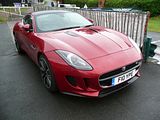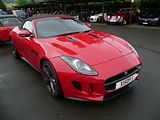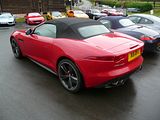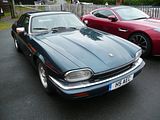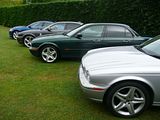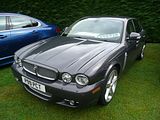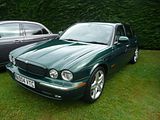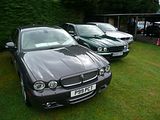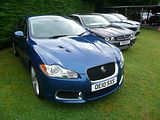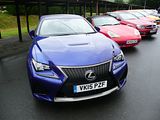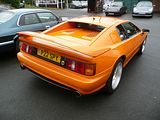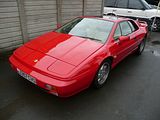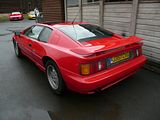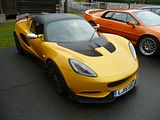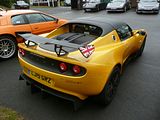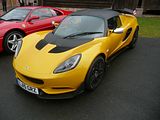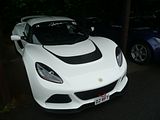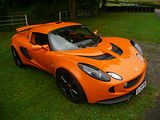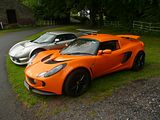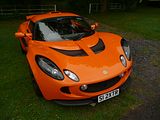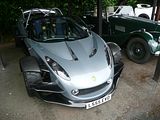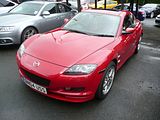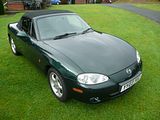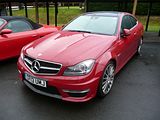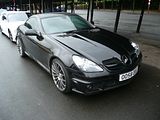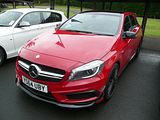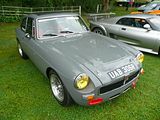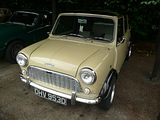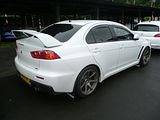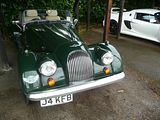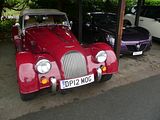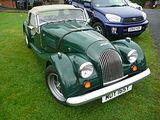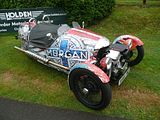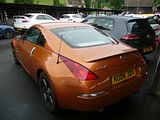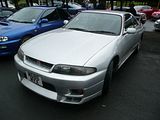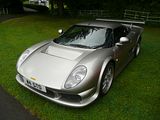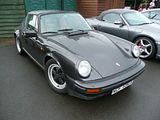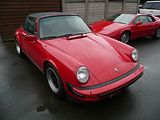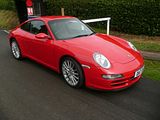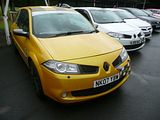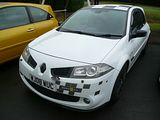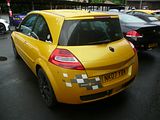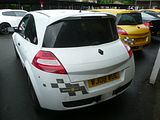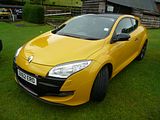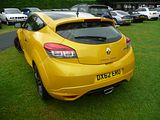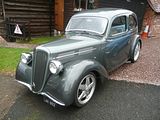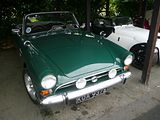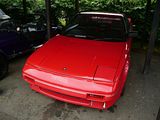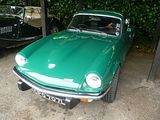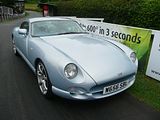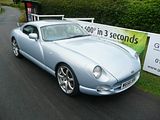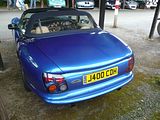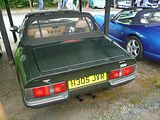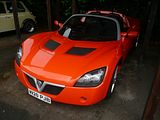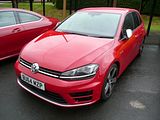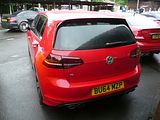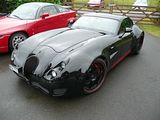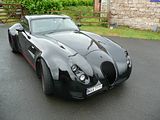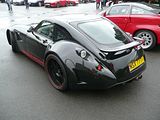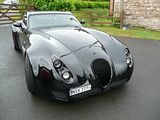Whilst the monthly Shelsley Walsh Breakfast Club meeting does not quite amass the same number of cars as crowd into Bristol’s Queen Square, there is still usually more than enough to keep the car enthusiast entertained for the best part of a morning, and I have always enjoyed my trips up to this picturesque spot in the Teme Valley when I have been looking for a different venue and selection of cars from the one that is relatively on my door step. In July, as well as clashing with the Bristol event, which it does each and every month, the Breakfast Club was also on at the same time as the nearby inaugural restaging of the Chateau Impney Hill Climb. As I had booked a ticket for that event for both days, I figured out that I could stop off at Shelsley en route up to Droitwich for the bigger gathering of the day. Evidence later in the day suggested that I was far from alone in having that thought, as many of the cars which I saw at Shelsley were also to be found in the car park at Chateau Impney. More of a concern, when planning my weekend, was the weather forecast, with a belt of heavy rain likely to pass over Worcestershire (and indeed a rather larger area than just that!) on the Sunday morning, which led me to wonder whether there would be enough cars at Shelsley to make my detour there worthwhile. Whilst the venue was not as busy as it had been in May, I need not have worried, as there were plenty of people who decided to head on to this venue, and a wide variety of interesting cars well worth looking at and a photo or two, as this report will evidence:
ABARTH
Lone representative of the Scorpion brand was this 595C, which arrived mid-morning. I did not see it pull in, so did not catch the owners, but as far as I can tell, it is not a car owned by someone I know.
ALFA ROMEO
Two very different Alfas present. The familiar was represented by a current Giulietta Hatch, Alfa’s well-regarded family car that has been on sale for 5 years now The more unusual was this SZ, an example of the car nicknamed “Il Mostro” at launch in 1989. Boldly styled, these cars divided opinion like little else at the time, and they still have their fans and their haters even now, though the relative number of one to the other has probably shifted far more in favour of the model than use to be the case.
AUDI
My own S5 Sportback took its place in the line of what the organisers called “performance moderns”, which turned out, as you will see by scrolling through this report, to constitute the vast majority of the cars gathered (and certainly depicted!). Although quite subtly distinguished from the more often seen TDi models, plenty of attendees did recognise it as an S5, as I was listening intently to their comments without always letting on that it was my car.
AUSTIN HEALEY
Lone example of the much-loved British marque that brought together Donald Healey and the economies of scale that Leonard Lord’s Austin Motor Company could offer, with the 1952 creation of Austin-Healey, was this diminutive little Mark 1 “Frog Eyed” Sprite.
BMW
The press may have expressed mild disappointment at the latest M3 and M4, not least because the sonorous V8 of their predecessors has been replaced by a (very effective) twin turbo 3 litre in-line 6, but the market would seem (once again) not to agree with them, and these cars are starting to become a relatively common sight on our roads. There was one example of each of the Saloon and M4-badged Coupe here, and when I heard the latter fire up and drive off, once again, I concluded that there is no reason whatsoever to be disappointed at the noise that the car makes.
The 3 series notches up its 40th anniversary this year, in which time there have been 6 distinct generations. The first two of these pre-date the market’s real love affair with the model and premium sports saloons in general, so they are relatively rare now, as indeed they sold in far smaller quantities when new, so it was nice to see not just an E30 model but also the earlier E21 323i here.
A relatively late arrival at the event was this Z4 M Coupe.
CITROEN
Oldest car present was this glorious Traction Avant which appeared mid morning and only stayed a relatively short while.
FERRARI
The duo of Ferrari models that came to the event were both 8 cylinder cars, and by common consent, among the most attractive of recent models to bear the Prancing Horse logo. They were a F355 Berlinetta and the car which replaced it in the range, the 360 Modena
FORD
There were performance Fords a-plenty here. Most numerous, unsurprisingly were Focus models, with ST versions from the second and third generations of Ford’s popular family hatchback on show. The two third generation cars represented the pre and post facelift styling.
There were also 3 of the RS models, two of the second generation car and one of the first type to bear the legendary letters in its badge.
Prior to the Focus, Ford’s mid-sized family car was the Escort, a model which ran for 30 years from 1968 to 1988, in four distinct different generations, though in inimitable Ford fashion, each was facelifted and updated, the last of them as a matter of necessity as the launch product was so poor, so you will hear people refer to lots of different “Mark” versions which do not always align. There is no confusion, however, with the Mark 1 cars, a conventional rear wheel drive saloon that ran from 1968 to January 1975, and which quickly established a formidable reputation in motorsport, leading to the creation of road going versions of some of the successful rally and race models. Of these, the most numerous and best known are the Mexico, so called after the model’s success in the 1970 London to Mexico rally, and the Escort RS2000 which was launched in the autumn of 1973 as a more civilised version of the raw RS1600 car, examples of both of which were to be seen here.
RS versions of the follow on car, the Mark 2, came along soon after the January launch of the regular models. The RS1800 was the first to appear and this was quite an extreme (by the standards of the day) machine, but a more civilised RS2000 with unique front end styling came a few months later. For those who could not quite run to these, there was a 1600 Sport model, which was still a cut above the big-selling 1100 and 1300cc models.
Even the regular Fiesta models have something of a sporting feel to them, thanks to their excellent steering and handling characteristics, but Ford eventually did the sensible thing and produced an ST version, and ever since have struggled to build them fast enough. In regular guise this is a great car to drive, I believe, but take it to have the Mountune kit fitted, as many owners have done, and it reaches an even higher level of excellence. Shown alongside it was one of the lesser models, a Zetec S Red.
JAGUAR
One of the most desirable cars currently on sale – both to look at, and to listen to, qualities I can assess from outside the car, and doubtless to drive, though that is a pleasure still in-store for me – is the F Type and there were examples of both the Coupe and the Convertible here.
There was also a nice late model XJS, a car which has aged well, and is now attracting far more interest than it did when new. The model celebrates its 40th anniversary in a few weeks time, and there have been a number of tributes in the classic car press in recent times, all of which spell out how the car is still a bargain, and suggesting you may wish to buy a nice one while you can still afford to do so.
Jaguar saloons were represented by a line up of XJ8 models, of the X350 and X358 type and an XF
LEXUS
This RC-F was making another appearance at the event, having been seen here in May, as well as at Prescott on a number of other occasions. It is the only RC-F I have seen on the roads of the UK, which is perhaps not surprising, as the market for cars like these, especially without the M or AMG badge on it is rather small, and by all accounts, even if you like the looks (which I do not!), it is not quite as good a car to drive as either of the German rivals. A niche taste.
LOTUS
Also celebrating its 40th this year is the Esprit, that distinctive mid-engined Lotus that was penned by Giugiaro, and which had first been seen as a concept car some three years earlier. The model had a shaky start, with a number of issues, of which build quality was only one, afflicting the early cars, but Lotus gradually worked through many of the criticisms, and sales rose steadily. With funds limited, a clever Peter Stevens restyle of the car kept it looking fresh and ready for what turned out to be a longer production run than that of the Giugiaro car. More power had originally come from bolting a Turbo onto the 1973cc slant four Lotus engine, and whilst this remained one way of making the Esprit go like its looks suggested it ought to, Lotus developed their own V8 engine for the car and this was a popular option in the 1990s. All these changes mean that there are quite a number of different versions of the car to look out for. Two of them were to be seen here, a GT3 and a Turbo
“Number of different versions” is certainly a phrase that applies to the long running Elise. The Series 2 cars have been on sale since 2002, so it is perhaps no surprise that they have evolved somewhat in that time. A couple of recent examples were on show.
The first Exige was little more than an Elise with a fixed roof, and more power, from its VHPD K Series engine, aimed at the track more than as an everyday road car. Whilst the second generation model was a little more habitable, this is still a compromised machine. Accept it for that, though, and I am sure that you would enjoy as the owner of this S2 clearly does.
It was good to see a 340R present. As there had been one at the Classics in the Walled Garden event I had attended a few days previously, that means that I had seen 2 in less than 2 weeks, and these are rare models, as just 340 of the model were built, in 2000. Based on the Elise, the 340R had a custom built bodyshell with no roof or doors. All cars came with a silver and black colour scheme. The car used a tweaked version of the familiar Rover K-Series engine called VHPD (Very High Power Derivative) used in the regular Elise, producing 177 bhp at 7800 rpm and 127 ft·lb of torque at 6750 rpm as standard, or 187 bhp at 7500 rpm and 139 ft·lb at 5600 rpm with optional Lotus accessories. Weighing just 700kg, this was sufficient to give the car a 0 – 60 time of just 4.4 seconds. Special A038R tyres were developed for the 340R in collaboration with Yokohama. Whilst it is road-legal in the UK, most of the surviving cars are used for racing, track use, or demonstrations.
MAZDA
Nice to see an example of the RX8 as well as Mazda’s immensely popular MX5, here in third generation NC Series
MERCEDES
All the Mercedes models here were AMG cars, and there were several of them, with a C63, an SLK55, the larger SL55 as well as the current A45. Look at the last one, and compare it with some of the older ones and you can see how Mercedes is evolving. AMG used to be all about well-engineered mechanical upgrades, with just enough visual changes to leave the expert in do doubt that they were looking at something special. But the A45 AMG is an in-your-face over-stylised device that shouts ” look at me and get out of my way”. That will appeal to some, of course, but not perhaps the sort of person who aspired to (and could afford the steep price tags) an AMG of yore.
MG
This MGB GT has clearly been adapted for use on track rather than the road.
No, I don’t think of it as a “real” MG, either, but if you go to large gatherings of MGs or “BL” related cars, you will now see a number of the MG3 Hatch model parked up along with the classic Abingdon and Longbridge products. Opinions vary on the merits of the car, with a low price and quite decent driving dynamics meaning that you should perhaps not dismiss it as readily as most of us otherwise would.
MINI
The couple of modern MINIs were relegated to a parking area out of the way (along with other contemporary stuff), meaning that the only Mini in the main event was one of the Issigonis-designed ones, a lovely Cooper S.
MITSUBISHI
Along with rival rally-iste Subaru, which will appear further down this report, Mitsubishi capitalised on their success on the special stage with a series of road-going versions of their rally weapon, the Lancer Evo. Sold over a 20 year period in 10 distinct generations, these cars proved very popular with a certain type of buyer, even though they require fastidious attention to the frequent service intervals and are hardly cheap to run. Blisteringly fast, not just in a straight line, they are certainly classics of the future if not now, and unlikely to be seen again in this more eco-conscious age. A couple of different generation Evo models were to be seen here.
MORGAN
Another popular car at this event, not least, not doubt, as the Morgan factory is only a few miles away in Malvern Link. There were three examples of what everyone thinks of as “the” iconic shape, the Plus 4 as well as one of the enormously popular current Three Wheelers, which has been treated to the “Pop Art” experience.
NISSAN
Two very different performance Nissan models here: a 350Z sports coupe and the larger, and very rapid Skyline GT-R
NOBLE
M12 3GTO
PORSCHE
There were a number of 911s here, as ever, with a variety of the different generations of the model on display. These included a couple of Targa models from the 1980s, as well as a later Turbo and a 997 Carrera and a GT3
RELIANT
This Scimitar SS1 makes frequent appearances at Shelsley. The SS1 was a brave effort, but which never delivered on the potential of the concept. When word leaked out in the early 1980s, that Reliant was developing a small two seater sports car, everyone got rather excited. But the result was something of a disappointment, with rather gawky lines penned and not that much driving fun thanks to the (cheap to acquire) Ford CVH engines under the bonnet. Whilst the upgrade to the 1800cc turbo Nissan engine addressed the relative lack of go, the real problem was that a low volume manufacturer could not compete against one of the automotive giants and one of these, Toyota, launched a mid-engined rival even before the Reliant could establish itself in the market. Although production soldiered on for 10 years, rather than building 2000 cars a year, as the Tamworth maker had planned, only around this number were made in a 10 year period.
RENAULT
Renault’s volume products these are best described as worthy but dull, but car after car that has had the RenaultSport treatment has come alive and been transformed into being one of the best vehicles in its class. That is particularly true for the mid-sized Megane, so no surprise to find a couple of examples of the second generation car in RS230 guise here along with one of the replacement third generation models, an RS265
STANDARD
When I first saw this car pull in, I guessed, as I am sure many others would have done as well, that it was Ford based, though something told me that it looked slightly different from the Popular which is often customised in the way this one had been. Closer inspection revealed that it is in fact based on a Standard Flying Nine of the 1930s.
SUBARU
These days, Subaru make a series of worthy but rather dull vehicles, leveraging their standard all wheel drive for some vestige of off-road capability, and sales right across Europe are so insignificant that one wonders how long the marque will bother trying to sell their cars here. It was not always like that, of course, and it was cars like these Mark 1 and 2 Impreza models seen at the event which were hugely desirable as they were not just the road-going version of cars that wowed everyone on the rally stage with the likes of the much-missed Colin McRae and Richard Burns behind the wheel, but also because they were really rather good.
SUNBEAM
Sunbeam launched their rival to the MGA in 1959, and dusted off the Alpine name which had previously been applied to the larger open-topped version of the Sunbeam-Talbot 90. The first cars sported large tail fins, as was the fashion for the year, but these were quickly toned down, in one of the many revisions that were made to the model. Rootes Group, who owned the Sunbeam name made more or less annual changes to all their cars, with a steady program of mechanical and other updates, which meant that during the 7 year life of the Alpine, there were 5 different Series. This is one of the last, a Series V, which had the larger 1725cc engine under the bonnet. From 1962, the Alpine had to contend with the MGB as its main rival, and far more people voted Abingdon than Coventry, meaning that whilst the MG is a very common sight at car events, the Sunbeam remains quite rare, and that is a pity, as I think it looks at least as good, if not better, and the later cars were apparently not bad from behind the wheel, either.
TOYOTA
Slowly, interest in older Japanese cars is increasing, and it is machines like the MR2 that have contributed to that. The first model, like this one, launched in 1984, was a brave effort by a mainstream manufacturer, considering that no-one else had come up with a new 2 seater “affordable” sports car since the Fiat X1/9, some 12 years ago, but it paid off, proving that there was a market for the genre, and encouraging the likes of Mazda to invest in their MX5, and a whole set of other cars that would follow.
TRIUMPH
Sole Triumph at the event was a GT6 Mark 3, a car that some consider as a mini-E Type, with similar styling, but scaled down somewhat. Others see it more as a BL in-house rival to the MGB GT, which always outsold the Triumph and by some margin. This latter is probably nearer to the way the market viewed the car when new, though the GT6 was smaller than the MG. as it was based on the Spitfire. It did have the sophistication of a 6 cylinder 2 litre engine to power it, and once the rather challenging handling characteristics of the early cars had been tamed, this meant that the car was good to drive. It did not sell particularly strongly, though, and the model was deleted in 1973, some 8 years before production of the Spitfire ceased.
TVR
You rather expect to see TVRs at an event like this. and indeed there were some. Three to be precise: the Cerbera and Chimaera representing the Blackpool firm’s hayday of the 1990s when it seemed they could do little wrong (apart from the build quality and reliability which remained somewhat random), with each model more extreme than the last. Also with this duo was an example of the car which laid the foundations for all this, the S, a late 1980s reinterpretation of the “classic” TVR shape which saw sales expand in a way that the “Wedge” TVRs had never managed to achieve.
VAUXHALL
Lone Vauxhall in the event was a VX220. Although it looks quite different, the VX220 and its Opel Speedster alter ego share much under the skin with the Lotus Elise, and indeed the cars were built for General Motors, by Lotus at Hethel. Quite unlike any Vauxhall that had ever come before it, the VX220 was the result of a deal between GM and Lotus, struck to generate enough funding for the latter to be able to develop a replacement for their Elise model, something forced on them owing to changes in European crash safety regulations for the 2000 model year. Lotus agreed to develop and produce a 2 seater sports car for GM, on the new Series 2 Elise chassis, with the a concept version of the proposed GM model being shown at the Geneva Motor Show in 1999. Although the body styling was different, clearly the economies would only work if as much else could be shared, and that presented a challenge as it was planned to use a 1.8-litre Toyota engine, similar to that found in the Toyota Celica, in the second generation Elise, whereas the GM cars clearly had to use a GM engine, namely the 2.2-litre GM Ecotec engine from the Astra. As neither engine had been used in the original Elise, which had been fitted with a 1.8-litre Rover K-Series engine, this simply became one of the many design challenges .In order to accommodate the production of the new cars, Lotus expanded its Hethel factory to a capacity of 10,000 cars, with around 3,500 slots allocated to Speedster production. Production of the Speedster commenced in 2000. The car was hailed by the motoring press as a great drivers’ car and won several accolades, including Top Gear’s Car of the Year in 2003. The lesser naturally aspirated 2.2 version was considered easier to drive than the potent Turbo model, and some journalists suggested that the Opel/Vauxhall car was better value for money than the Lotus, among them one Jeremy Clarkson in his 2003 DVD Shoot Out. However, the market did not really agree, and sales were limited. The car was deleted in 2005, with no successor.
VOLKSWAGEN
There have been R badged models at the top of the Golf range since the days of the Mark IV, some 18 years ago, but, although all of them have been blisteringly fast and as beautifully put together as any Golf or indeed VW is, none have really captured the imagination of the press and public in the way that the GTi did some 20 years earlier. Until, that is, the launch of the latest one, based on the Mark VII. This car has blown away everyone who has driven it with its competence in just about every regard, and it is regularly placed as victor in comparison tests whenever it appears. Subtle visual changes over the lesser Golf models are all part of the appeal, and whilst the signature colour blue is a very nice shade indeed, coming across one in a less common colour makes it almost even more incognito as a truly fast hot hatch.
WIESMANN
Without doubt the most unusual car at the event was this, a Wiesmann GT MF5. Based in Dülmen, Germany, Wiesmann was founded in 1988 by two brothers: engineer Martin and businessman Friedhelm Wiesmann. These cars were manufactured by hand in Dülmen, using BMW engines and transmissions. The Wiesmann logo portrays a gecko, as they claimed their cars “stick to the road like geckos to a wall”. The company originally manufactured custom hard-tops for convertibles, with their first car, the MF30, leaving the workshop in 1993. It was succeeded by a slightly revised model, the MF 3 Roadster and this was later joined in 2005 by the GT MF 4 Coupé. This car came with 3 different BMW V8-engines: the 4.8 litre with 367 hp, the later 4 litre unit from the M3 with 420 hp which was introduced with the MF4 Roadster and the 4.4 litre Turbo with 407 hp, which replaced the 4.8 litre unit in 2011. The first 9 GT MF4 cars had a 4,4 litre with 333 hp. At the 2007 Frankfurt Show, Wiesmann introduced the GT MF5, offered as a a closed two-seater and a two-seater roadster with BMW’s all-alloy 5 litre 500 bhp V10 engine as used in contemporary BMW M5 and M6 models under the bonnet. With Bi-VANOS variable camshaft control and, in addition to that astonishing 500bhp at 7750rpm, some 383lb ft of torque at 6200rpm, with each cylinder getting its own electronically actuated throttle valve, and four oil pumps and two sumps to ensure constant lubrication even during braking and cornering, this may not have been a Formula 1 engine, but in contrast to the beautifully calculated antiquity of the MF5’s exterior, it might as well have been. It allowed the MF5 to accelerate from 0-62mph in 3.9sec and hit a claimed top speed of 193mph, which was enough performance to warrant the addition of an aggressive rear wing and diffuser to generate a little more gecko-like tenacity at speed. The MF5’s surface-sticking capabilities were further enhanced over the MF4’s by the more hunkered-down stance and dimensions: a 5cm suspension drop, wider front and rear tracks (by 10cm and 9.8cm respectively) and an 8cm stretch in length. The standard BBS alloys were 19in in diameter, though larger 20 inch wheels were an unsurprising option. They are as much as 11.5in wide at the rear. The V10 is mounted low and behind the front axle line – the so-called ‘front mid-engined’ layout – and, as in the M5/M6, drive reached the rear wheels via BMW’s 7-speed sequential paddle-shift transmission, complete with its shift-speed control and variable-lock differential. Despite the bulkier engine and transmission, the MF5 still qualified as a lightweight. At 1380kg, it was just 100kg heavier than the MF4 and therefore had a significantly better power-to-weight ratio: 368bhp/ton versus 287bhp/ton. A sort of German TVR in concept, the future was looking quite bright for the company, and expansion plans called for the cars to be exported to the USA by 2010. However, unfavourable movements in the exchange rate and the high costs of modifying and testing the cars in order to make them road-legal there put paid to those plans. On August 14, 2013 Wiesmann filed for insolvency at the local court in Münster, and although the management board of the Wiesmann corporation fought against this, the company was liquidated in May 2014 What was particularly surprising was that the car here had right hand drive, as I was unaware that any had been made in this configuration., but in fact 5 or 6 were produced with the wheel on the right. A plaque on the centre console attested to the fact that this was car number 16 of 20 of the 20th Anniversary Edition cars made. It was ordered new with a view to exporting the car to Singapore, but the owner clearly had not done his research, as there would have been a 100% import duty to pay on the car, and when this came to light, he shelved the idea and the car went into storage.
Whilst not the busiest Breakfast Club meeting I’ve attended, it was still well worth the few mile detour off the M5 en route to Chateau Impney to come and join this one. As and when the diary permits, I will be back. Shelsley Breakfast Club meetings take place on the second Sunday of every month from February to October.


